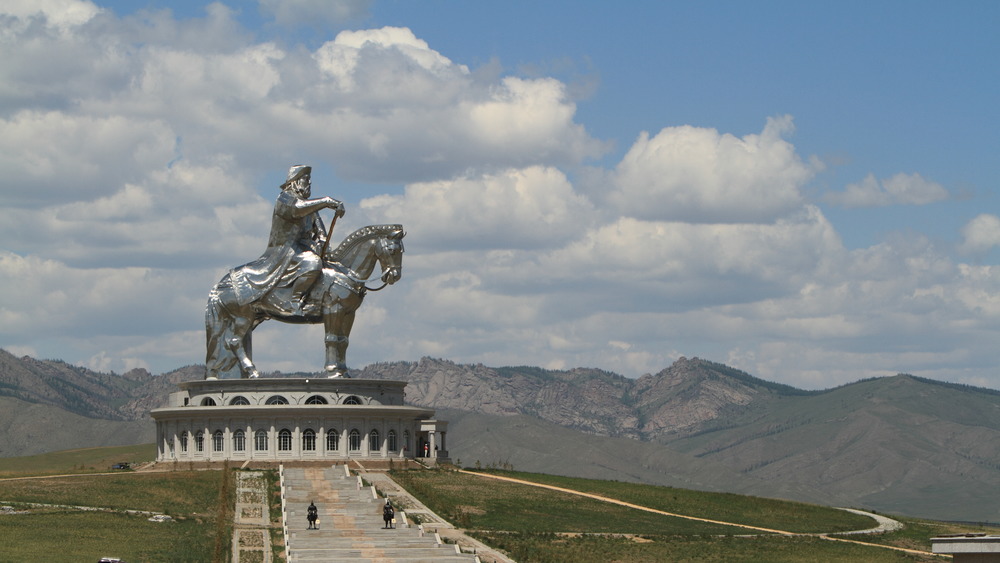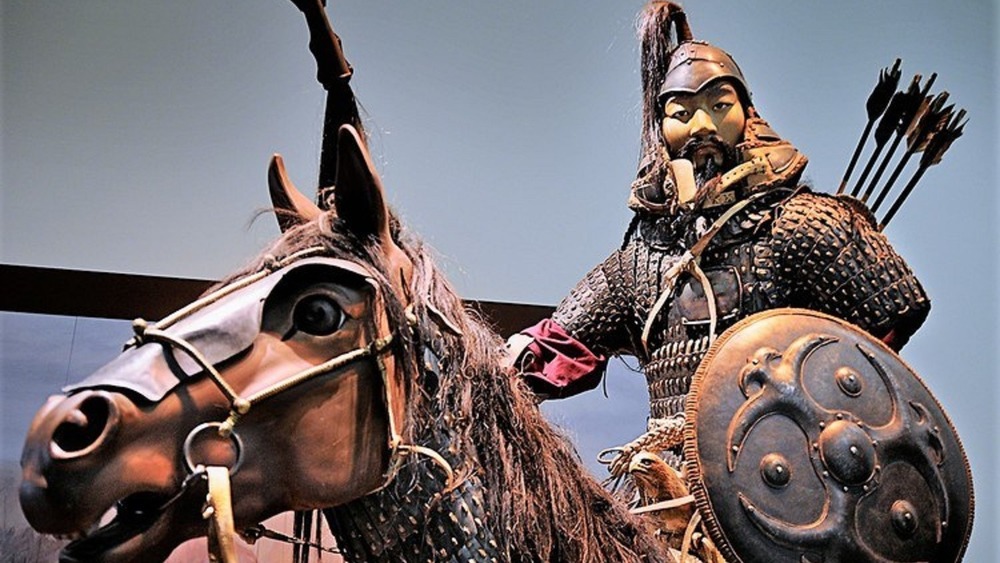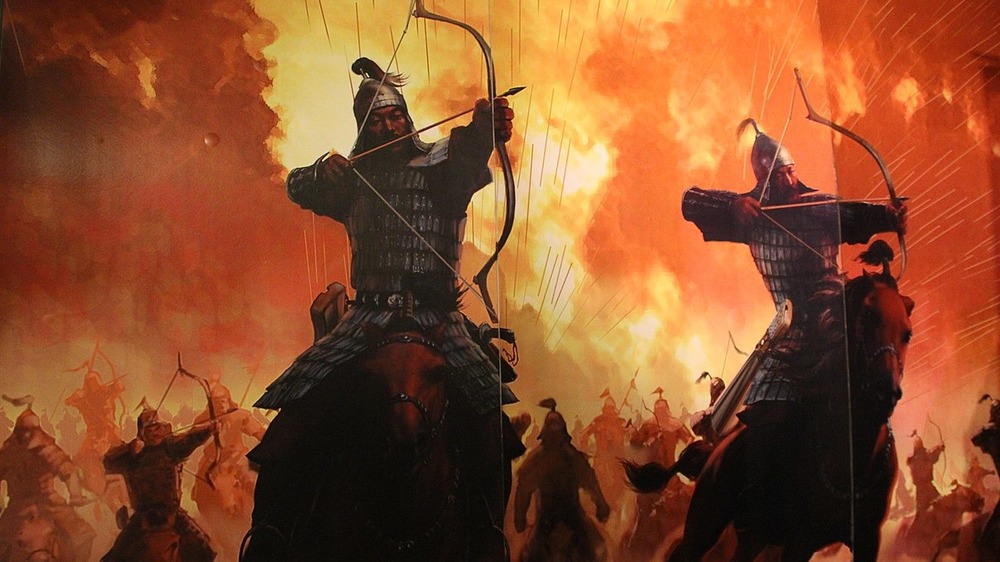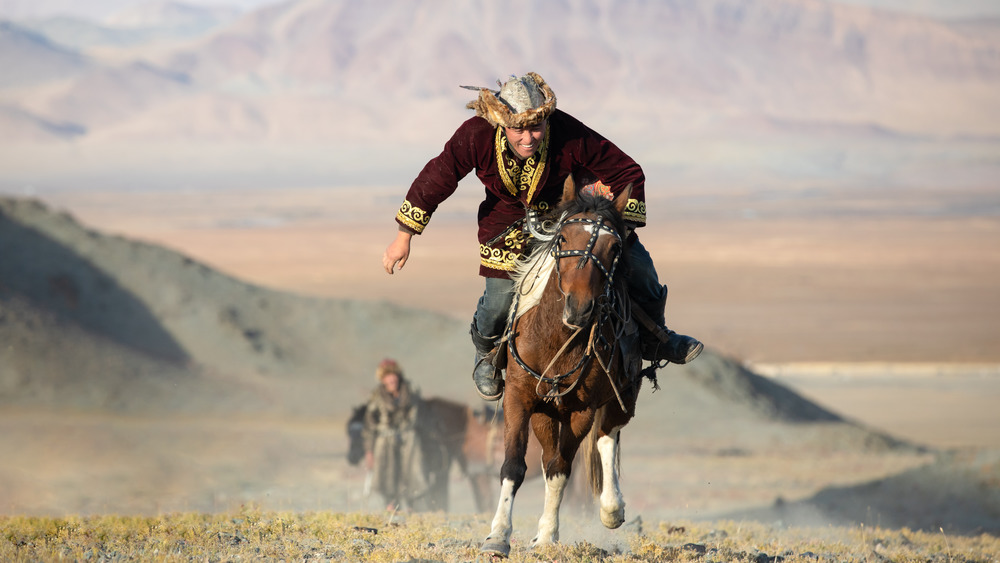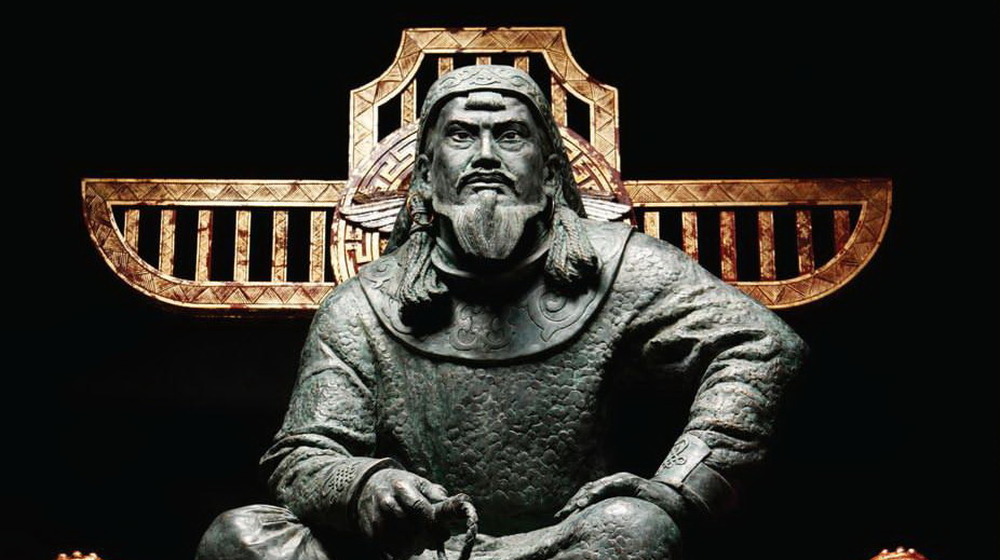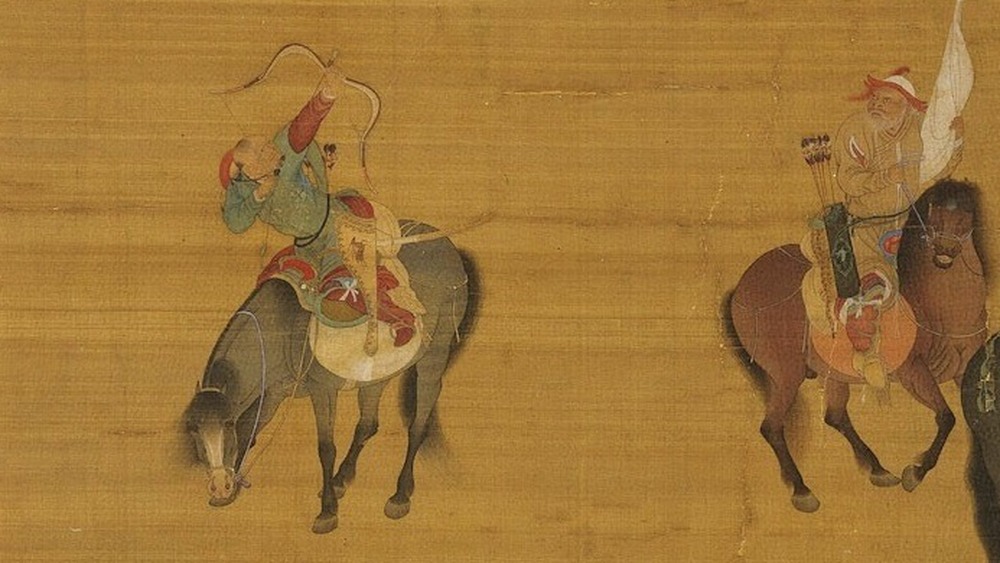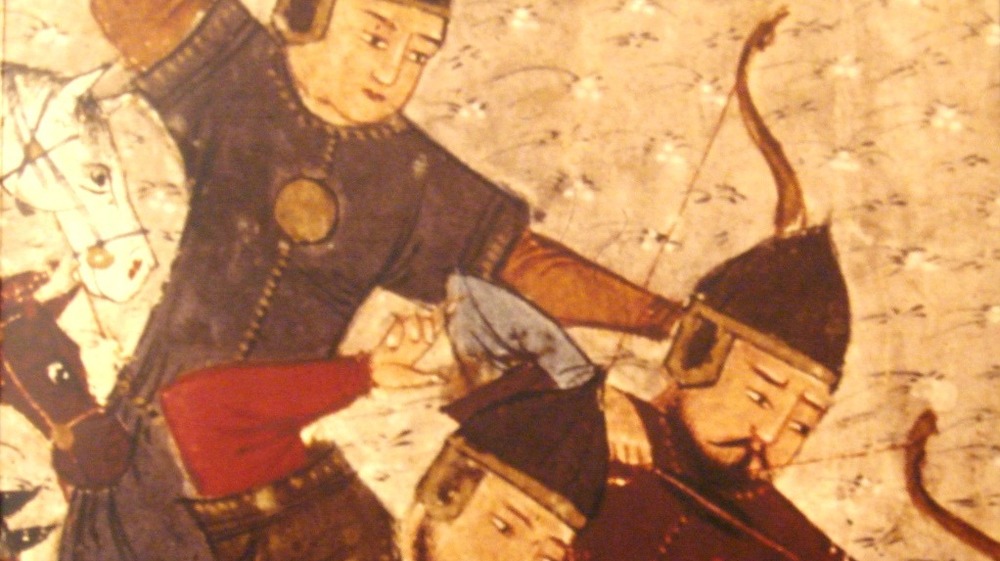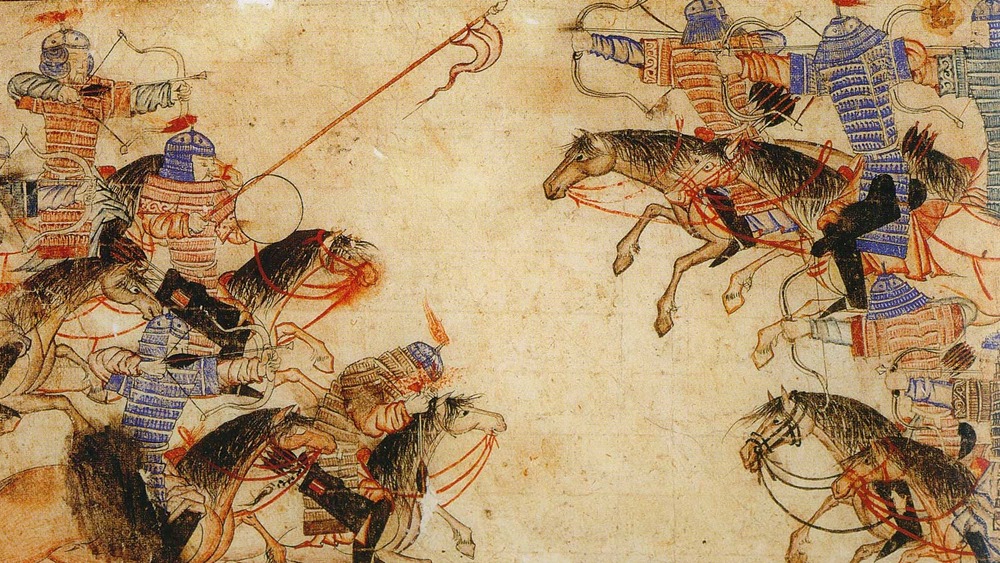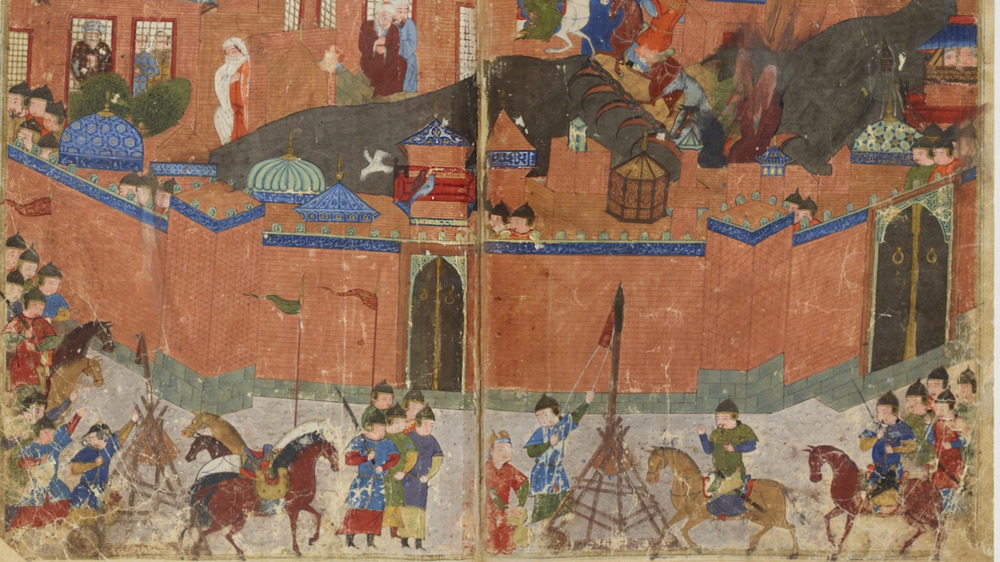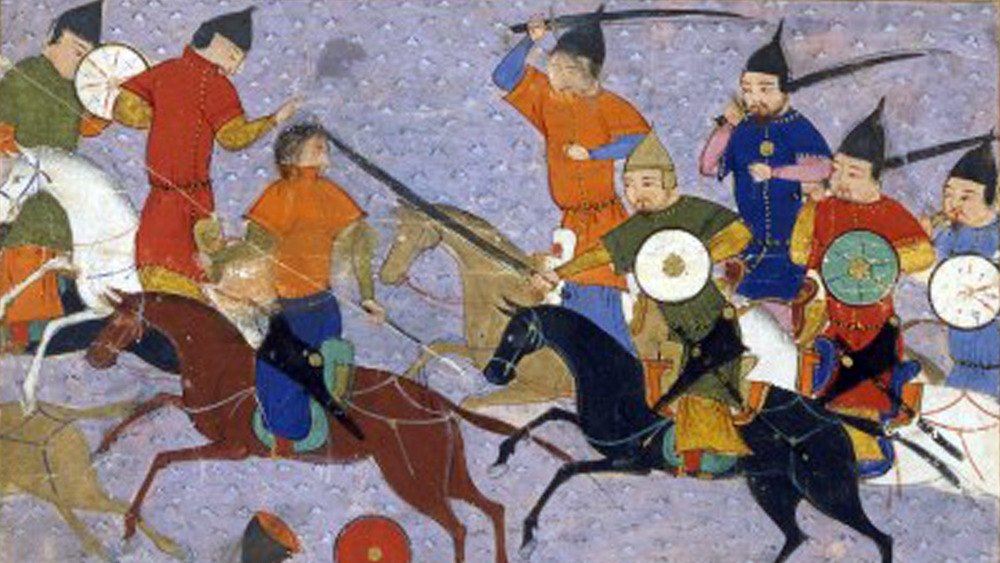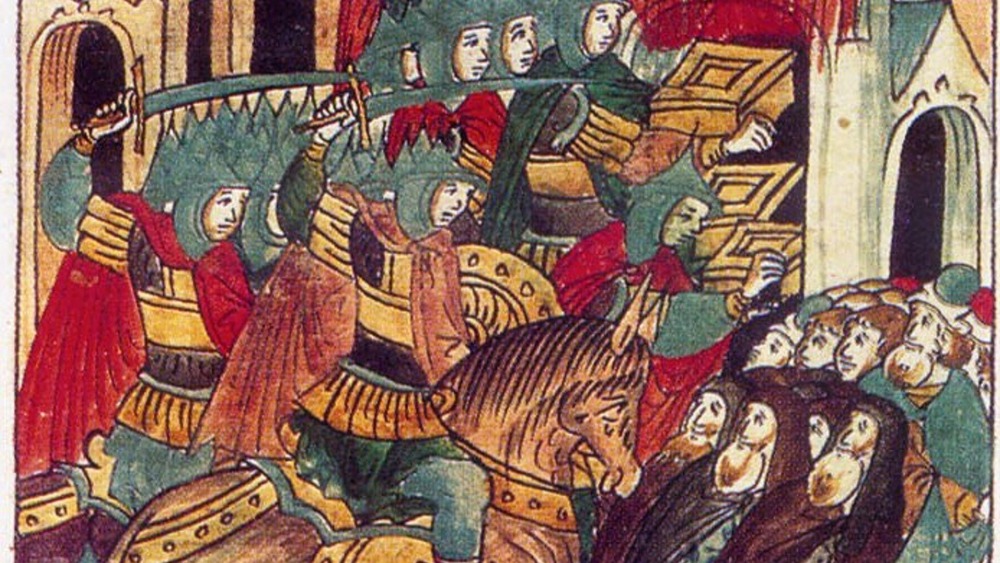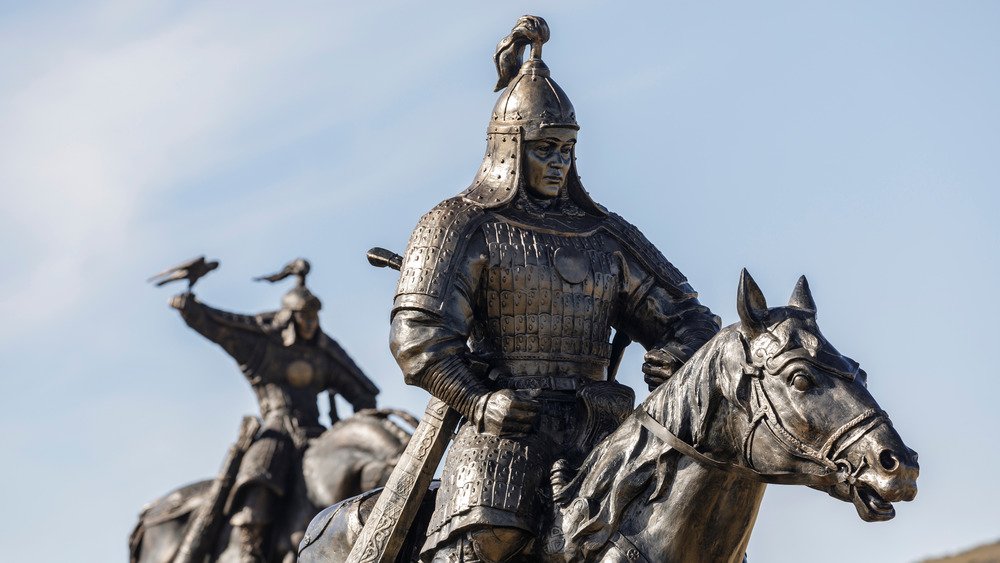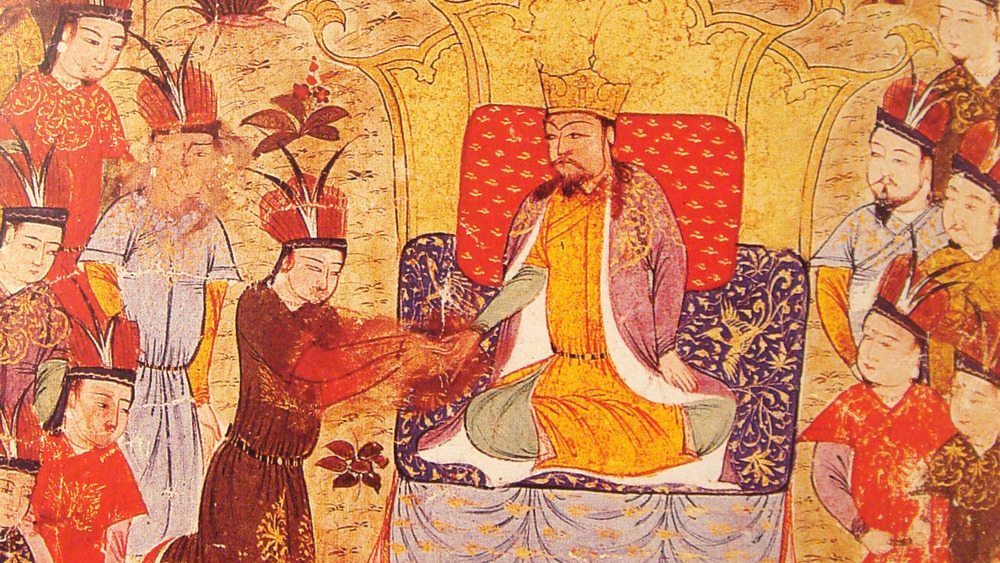Rules Genghis Khan's Warriors Had To Follow
In the 1200s A.D., the world was hit by the equivalent of a human-made meteor bombardment. Cities were leveled, millions killed, and empires turned to ash. At the same time, a great part of the world became united, trade was promoted, and the stage was set for the modern era. This tsunami of change started, according to National Geographic, in 1206 when a Mongol chieftain, Temujin (sometimes Temijin) united the various tribes of the steppes of Central Asia and took the name Genghis (or Chinggis) Khan, which roughly translates to "Universal Ruler." He was also the Khagan, a title which as described by National Geographic means the "Great Khan." He quickly turned to the conquest of the Islamic empires in the west and the Chinese dynasties to the south.
Even after Genghis Khan died in 1227, his empire continued to grow through the conquests of his successors, leading to a Pax Mongolica, which until the empire's end in 1368 created an enforced peace across Asia, which allowed for the expansion of trade, technology, and ideas. The cost, however, was millions of deaths and large swaths of destruction.
The tool which Genghis and his successors used to achieve all this were unparalleled warriors. They were raised with the object of warfare in mind. To be so successful, these warriors had certain rules and traditions that they had to follow. If they did not follow them then... well you shall see.
Being a Mongol warrior is not recommended, it is required
Genghis Khan was able to conquer kingdoms and empires with far larger, urbanized populations than his own. The reason for this was that Genghis Khan mobilized a much larger portion of his kingdom than other civilizations. According to Fighting Techniques of the Oriental World, all Mongolian males between the ages of 16 to 60 were liable for military service. Timothy May's The Mongol Art of War gives this age range from 15 to 70. Either way, it is clear that a large segment of Mongol society were warriors.
This is not to say that all these men actually went to war. What it does say is that on the whole, the Mongols recruited more soldiers per capita than other peoples. May cites that one out of every seven Mongolians was a warrior in a population of almost 665,000. Genghis Khan's army, at the time of his coronation in 1206, was 95,000. It is telling that as related by Stephen Turnbull's Mongol Warrior, there was no term in the Mongol language for "soldier" since it was a part of every man's being.
Genghis Khan's warriors must win despite tradition
The most important thing to Genghis Khan was victory. One world history textbook provides this gem attributed to Genghis Khan, "Man's highest joy is in victory: to conquer one's enemies, to pursue them, to deprive them of their possessions, to make their beloved weep, to ride on their horses, and to embrace their wives and daughters." Maybe this is why one in two hundred men are descendants of the Great Khan today.
It is no wonder that with such a single-minded attitude that Genghis Khan was willing to throw out traditional Mongol military techniques when needed. Discover Magazine relates his flexibility. He adopted foreign ideas and technologies. When his empire began to expand, and it became clear he needed to conquer cities, he quickly adopted siege technology. This attitude was taken up by his successors who, as described by the Ancient History Encyclopedia, used rockets, naval warfare, and early gunpowder weapons to achieve victory. The Mongols even used Greek fire. Despite this, results were sometimes mixed. The Mongols after Genghis Khan launched naval invasions of Japan, which failed due to storms and major resistance. Ultimately, the core of the Mongol military machine, and what made Genghis Khan's warriors so legendary, was its cavalry.
Mongol warriors must be expert horsemen
The primary factor to Genghis Khan's success was his use of cavalry. The Mongols were nomads of the grasslands of Central Asia and depended on the horse in their daily lives. According to Daily Life in the Mongol Empire, all Mongol children were taught, by law, horsemanship. The horse was about the size of a pony. National Geographic relates that the typical Mongolian breed of horse today is 4.6-feet high and is the same breed used by Genghis Khan's warriors. The Mongol horse's characteristic that made it a key tool for Genghis Khan was its endurance. These horses raced across the vast Eurasian steppes and also withstood temperatures ranging from -40 to 90 degrees Fahrenheit.
Critical to Mongol success was also the use of metal stirrups. Arstechnica explains that the use of stirrups enabled Genghis Khan's warriors to ride farther, to stay in the saddle in battle, and to effectively use the bow and arrow on the move and in all directions. When going to war, a Mongol warrior might have five or six horses with him for remounting, according to Mongol Warrior.
The Mongols and the horse are a point of cultural pride and a source of sport and competition today at the Mongol Derby. The race, which is modeled on Genghis Khan's relay postal routes, features riders who transverse a 621-mile circuit in under ten days, changing horses at 25-mile intervals. This race is the longest equestrian endurance event on Earth.
Mongol warriors must drink blood (when required)
It seems pretty clear that Mongol warriors relied heavily on their horses. This was not just limited to warfare. Morris Rossabi of Columbia University relates how Mongol horsemen used horses for sustenance, while on campaign, as a source of milk. This milk was at times fermented to create kumiss, also known as araq, which was an alcoholic beverage favored by the nomadic people of Central Asia. If a Mongol warrior on a long journey had no other supply of water or food, he would make a slit in his horse's neck and drink the blood for sustenance.
Marco Polo reported, "And in case of great urgency they will ride ten days on end without lighting a fire or taking a meal. On such an occasion they [the Mongol riders] will sustain themselves on the blood of their horses, opening a vein and letting the blood jet into their mouths, drinking till they have had enough, and then staunching it." Rossabi quoted one Mongol commander as stating, "If the horse dies, I die; if it lives, I survive." It is no wonder that Genghis Khan's warriors had multiple horses.
Genghis Khan's warriors must be amazing archers
To be one of Genghis Khan's warriors, you needed to know how to be an expert bowman — especially while riding a horse. The weapon of choice for Genghis Khan's warriors was a composite bow. In its day, it was cutting edge. Sam Fadala in Traditional Archery writes that the Mongol warrior's bow was made of a combination of materials built off a wooden core. The bow also contained animal horns and sinews. The Mongol bow also had a unique shape. It was very recurved and powerful. An expert archer could shoot up to 500 yards and pierce armor.
Yet what made Genghis Khan's warriors most effective was their ability to integrate their mastery of the horse with their shooting skills. According to Britannica, Mongol warriors typically carried a longer bow to shoot from the ground and the shorter bow to use while on horse. The Mongol Warrior relates there were a variety of arrowheads that Genghis Khan's warriors chose from, including poisoned arrows to ones that could whistle in order to communicate at a distance. The arrows themselves were fletched with eagle feathers, and a warrior typically carried 60 into battle.
The horse archers used their weapons for long-range harassing tactics but also for deadly medium-range engagement. As a testament to their skill, warriors could shoot from the saddle backward at full gallop as highlighted by Medieval Islamic Civilization. Aside from bows, Mongols also carried curved swords, axes, spears, and maces.
Mongol warriors must be ready to hunt lots of wild animals at the same time
Genghis Khan and his warriors were the product of a nomadic culture whose lifestyle prepared them for war. Cultural events were used as training exercises. One example of this was the nerge, or Great Hunt. The nerge, according to Daily Life in the Mongol Empire, was at its simplest a hunting circle. However, Genghis Khan reinvented the pastime to become an earnestly serious training exercise. Over a vast distance, an army of organized warriors chased, enveloped, and encircled all the animals in a given area. Once the encirclement was complete and all the game trapped, the circle started to contract until a killing field was presented.
To give you an idea of how large-scale the nerge was, the initial line of hunters could around 80-miles long and involve multiple units of 10,000 men each. At the point of almost complete contraction, there was utter pandemonium among the entrapped animals, ranging from lion to bear to deer, all bellowing, roaring, and bleating. The khan slew the first animal before Mongol nobility took a turn and then the soldiers. After the mass slaughter, nine days of feasting followed.
The nerge took intense coordination and was run as a military drill. Communication, martial skill, and organization were critical to a successful hunt. Warriors who did not do what they were supposed to do were punished, some by execution. The circling tactics of the nerge were directly transferred into Mongol military tactics.
Genghis Khan's warriors must retreat to achieve victory
Genghis Khan was a military genius who used the strengths of his people to deadly effect capitalizing on extreme speed and surprise. According to Mongol Warrior, the Mongolian army used scouts in force, often riding up to 70 miles ahead of the main body of troops. This meant that any enemy who came in contact with the Mongol army would alert its center which, using its superior mobility, moved to encircle it like the nerge. This was often accomplished through the use of strategic retreats. A detachment of warriors engaged a hostile force, then suddenly turned and withdrew. This baited the enemy army into pursuing them. As they did so they were drawn deeper into a trap. Their lines were stretched out. Then the wings of the Mongol army snapped shut as the retreaters now turned and gave battle.
This tactic was highly successful even when the Mongol's enemies were very much aware of their use. After successfully disrupting the enemy through these methods, the final blow usually came from Mongolian heavy cavalry armed with melee weapons.
These tactics were fruitful for Genghis and his successors. The Encyclopedia of Ancient History notes that in most battles, the Mongols were outnumbered, but they won anyway because of these superior tactics.
Mongol warriors must not want a salary
In almost all cases, the Mongol warriors led by Genghis Khan neither earned a salary nor had a 401(k) plan. Yet, according to the Mongol Warrior, each soldier could expect to become rich under the khan from booty. The Cambridge History of War relates how Genghis Khan decreed that all warriors would receive a share of the spoils of war but only after the enemy was completely annihilated.
What this meant practically was that splitting up the loot was not a free-for-all. Everything was collected and then distributed, so if a Mongol detachment was in hot pursuit of a fleeing enemy, it wouldn't get distracted to go loot a merchant caravan and the like — his fellow warriors would do it, and he would still receive a share of the total spoils. To enforce this rule, the Mongols had a judicial body called the jarqu, which according to Paul Buell's The A to Z of the Mongol World Empire, ensured a lawful distribution of booty.
Mongol warriors do not care who your parents are
One often underlooked feature of Genghis Khan's war machine was that it was an equal opportunity employer. Paula Sabloff in her book, Modern Mongolia, asserts that in 1206, Genghis Khan created the empire's first law code, which established rule of law. This enabled Genghis Khan to promote some form of equality in Mongol society. This concept transferred to his army, which promoted warriors based on skill and valor. A commoner could achieve high rank in the empire by merit of ability alone.
This was not just limited to men. Mongol women, while still limited, were in comparison to other cultures around the world, given remarkable freedom acting as political advisors to the khan. One woman, Khutalun, who lived a generation after Genghis Khan, was known for her physical strength and wrestling prowess. In Morris Rossabi's biography, Kublai Khan, he relates her military skills and how she regularly defeated men in wrestling contests. This equanimity was related by the Persian historian Ata-Malik Juvaini who wrote that the Mongol army was like "...a peasantry in the guise of an army, all of them, great and small, noble and base, in time of battle becoming swordsmen, archers and lancers and advancing in whatever manner the occasion requires."
As Genghis Khan's empire grew, he recruited from other peoples. While, as Mongol Warrior relates, they were not Mongol warriors in the strictest sense, serving as footmen and auxiliaries, they were critical in allowing Genghis Khan to achieve his imperial ambitions.
Genghis Khan's warriors must be okay with terror tactics
Genghis Khan was one of the most successful generals in history, not just because of his tactics on the battlefield but also because of the terror he inspired in his enemies. According to Medieval Warfare, Genghis Khan led the wholesale destruction of the Khwarizmian Empire, which included extensive looting, genocide, and destruction. After the conquest of the city of Bokhara, Genghis Khan as quoted in George Lane's Genghis Khan and Mongol Rule, said to the vanquished, "...I am the punishment of God. If you had not committed great sins, God would not have sent a punishment like me upon you."
Mongol Warrior relates numerous instances of Genghis Khan and his successors slaughtering entire populations if they did not surrender. In one example, according to Jack Weatherford's Genghis Khan and the Making of the Modern World, the city of Urgench near the Aral Sea resisted Genghis Khan's armies for six months. Even after the Mongols breached the city's walls, the citizens resisted in the ruins. In order to deal with this unacceptable situation, the Mongols diverted a river by building a dam. They then flooded the city, killing the remaining defenders, laying Urgench waste. In another instance reported by Discover Magazine, Mongol warriors used captives as body shields while besieging a city.
According to Britannica, approximately 40 million people were killed due to Genghis Khan's conquests, particularly in China and Iran.
But Mongol warriors must be tolerant
With all the blood and gore you just read about, you might think that living under Mongol rule must have been horribly repressive. As strange as it sounds, the Mongol empire, starting with Genghis Khan, had fairly tolerant attitudes, at least toward religion. According to Columbia University, while the Mongol practiced their own shamanism, they felt it was a wiser decision to let the people they had just subjugated practice their own religion. In fact, they even went so far as to promote various religions with the belief that it would make the empire easier to rule.
Columbia also notes that Genghis Khan provided tax relief to favored religions such as Buddhism. Genghis Khan himself favored Taoism because they pledged they could prolong the khan's life. While he never converted to any religion, his relationship with a Taoist sage led to the creation of one of the major primary sources on Genghis Khan. Keep in mind that toleration was limited. Absolute obedience to the Great Khan was paramount.
Genghis Khan's warriors must obey or die
The most important rule that Genghis Khan's warriors had to follow was obedience. The Mongol armies were organized in a strict hierarchy. The Mongol Warrior relates that punishments were doled out to enforce military order. If a warrior dropped his pack or bow, then the warrior behind him was required to retrieve it or be punished. If a soldier was found to be missing gear, then the officer in charge of that man was punished.
Minor offenses were dealt with by a cane beating, which rose as the number of offenses increased, topping out at 37. More severe offenses resulted in execution. This included sentries falling asleep at their post, plundering without permission, retreat without permission, and desertion. Friar Giovanni di Plano Carpini admired Mongol warrior discipline writing, "These men ... are more obedient to their masters than any other men in the world, be they religious or seculars ... They rarely or never contend with each other in word, and in action never. Fights, brawls, wounding, murder are never met with among them."
The Mongols built the largest contiguous empire in history through their skilled warriors, but in the end, the way they built it hastened its own demise. When the empire fragmented several generations after Genghis Khan, the inhabitants of the conquered regions took pains to try to wipe the memory of the Mongols from history. Yet this was impossible, since the conquests of Genghis Khan and his warriors changed the world forever.
